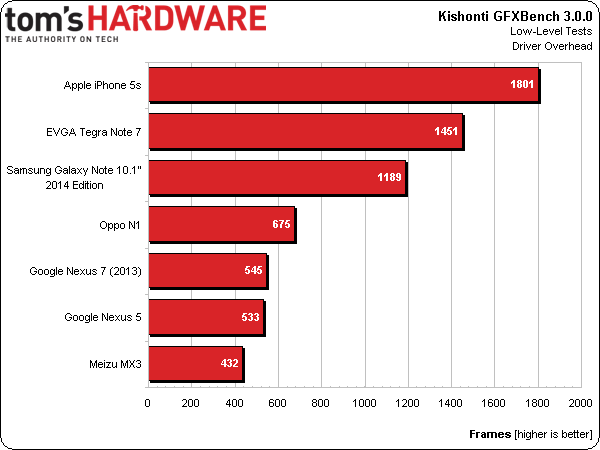GFXBench 3.0: A Fresh Look At Mobile Benchmarking
Over the past few years, Kishonti has become a leading name in mobile GPU benchmarking. The newly-released GFXBench 3.0 is comprised of nearly all new tests, including battery, render quality, and the first serious OpenGL ES 3.0 performance metric.
Low-Level Test Results: Driver Overhead
The Driver Overhead test is an OpenGL-based metric that applies minimal stress to the GPU, but taxes its driver by by rendering lots of simple primitives one by one, changing depth and blend state, plus shader uniform values like position, color, rotation, and size for each of them. The frequency of these state changes reflect real-world applications.
In doing this, the benchmark uses lots of draw calls. Its aim is to measure the summed CPU overhead of those calls, which are largely influenced by the driver. The results show how fast the software processes the various API calls.
We already know that software can have a real impact on performance, both in terms of CPU load and battery drain. Don't believe us? Just check out the whole debate between AMD's Mantle API and DirectX 11. Optimizing the way those calls are handled can really open up a processing bottleneck, resulting in additional performance.
This test measures driver overhead by rendering a large number of simple objects one-at-a-time, changing the device state for each of them, spitting out a result in total number of frames rendered.
On-Screen
First, the drivers are tested at each device's native resolution.
Apple's iPhone 5s is the clear winner. Its extensive experience with Imagination Technology's hardware and a stable software ecosystem appear to pay off, yielding an almost-25-percent lead over the nearest competitor, EVGA's Tegra Note 7.
The Galaxy Note 10.1” 2014 Edition shows up higher here than in any other test. Whatever sins TouchWiz has committed on performance in previous tests, ARM's Mali driver at least enjoys an advantage when we puts it efficiency to the test.
Get Tom's Hardware's best news and in-depth reviews, straight to your inbox.
Fourth spot goes to Oppo's N1, ahead of the Google Nexus 7 by around 24 percent. Because the N1's Snapdragon 600 runs at up to 200 MHz faster than the S4 Pro, we can see why it'd be able to handle more frames, given the same Adreno 320 graphics core. Less clear is why the Nexus 5's Snapdragon 800 would finish second-to-last, unless Qualcomm's Adreno 330 driver just isn't as optimized.
Off-Screen
Now the drivers are tested in a 1080p fixed off-screen resolution.
Taking the operation off-screen at a standardized resolution yields a similar finishing order, except that Apple's iPhone 5s extends its lead to 100 percent over the Tegra Note 7. That's impressive to say the least, but not particularly surprising considering that Apple has been writing and using software-managed OpenGL frame buffers since moving to OS X.
The Nexus 5 is able to marginally beat the Nexus 7, but still loses out to the Snapdragon 600-equipped Oppo N1.
Current page: Low-Level Test Results: Driver Overhead
Prev Page Low-Level Test Results: Alpha Blending Next Page Low-Level Test Results: Fill-
panzerknacker Its cool u guys put so much effort into this but tbh most of the benchmark results seem to be completely random. Phones with faster SoC's performing slower and vice versa. I think there is no point at all benching a phone because 1. The benchmarking software is a POS and unreliable and 2. The phone OS's and apps are all complete POSs and act completely random in all kinda situations. I'd say just buy the phone with a fast SoC that looks the best to u and when it starts acting like a POS (which they all start doing in the end) buy a new one.Reply -
umadbro What kind of bs is this? Force 720p on all devices and you'll see what happens to your precious 5s. Even my Zl murdered it.Reply -
jamsbong The only relevant benchmarks are the first two because they are full-fletch 3D graphics, which is won by the most portable device; The iPhone. The rest of the benchies are just primitive 2D graphics which is irrelevant. Android devices won all those in flying colours.Reply -
rolli59 Well I have a smart phone but that is so I can receive business emails on the go, I have a tablet because it is great for watching movies on the go. Do I want to find out if there are any faster devices to do those things, not really while what I got is sufficient. I leave all the heavy tasks to the computers.Reply -
Durandul ReplyThe only relevant benchmarks are the first two because they are full-fletch 3D graphics, which is won by the most portable device; The iPhone. The rest of the benchies are just primitive 2D graphics which is irrelevant. Android devices won all those in flying colours.
If those are the only two benchmarks relevant to you, then I wonder why you are using a phone and not a 3DS or something. But seriously, most of the other devices have more than a million more pixels then the iPhone, so this benchmark is not so telling. It was mentioned before, but it would be nice to test at a given resolution, although as suppose applications don't give you an option on the phone. -
umadbro Reply
It does give the option to force some specific resolution. Don't know why this "review" didn't do it. That's what I've been trying to say from the start.The only relevant benchmarks are the first two because they are full-fletch 3D graphics, which is won by the most portable device; The iPhone. The rest of the benchies are just primitive 2D graphics which is irrelevant. Android devices won all those in flying colours.
If those are the only two benchmarks relevant to you, then I wonder why you are using a phone and not a 3DS or something. But seriously, most of the other devices have more than a million more pixels then the iPhone, so this benchmark is not so telling. It was mentioned before, but it would be nice to test at a given resolution, although as suppose applications don't give you an option on the phone. -
umadbro Reply
It does give the option to force some specific resolution. Don't know why this "review" didn't do it. That's what I've been trying to say from the start.The only relevant benchmarks are the first two because they are full-fletch 3D graphics, which is won by the most portable device; The iPhone. The rest of the benchies are just primitive 2D graphics which is irrelevant. Android devices won all those in flying colours.
If those are the only two benchmarks relevant to you, then I wonder why you are using a phone and not a 3DS or something. But seriously, most of the other devices have more than a million more pixels then the iPhone, so this benchmark is not so telling. It was mentioned before, but it would be nice to test at a given resolution, although as suppose applications don't give you an option on the phone.


